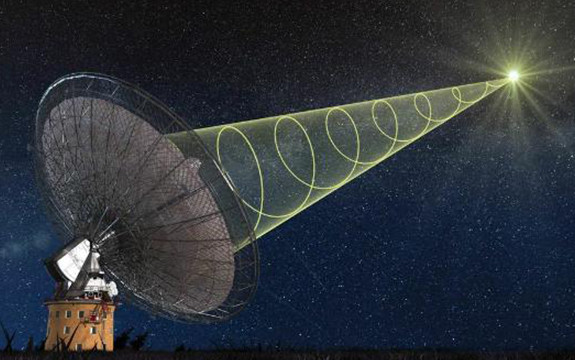Locating mysterious bursts places Universe on the scales

In Summary
The discovery of a fast radio burst has enabled scientists to conduct a unique census of the Universe’s electron count.
They confirmed that just four per cent of the Universe’s mass is everyday matter with the rest hidden in dark matter and energy.
An international team of scientists has identified the precise location of a very rare explosive event, called a fast radio burst (FRB) in a distant galaxy, for the first time.
Using a combination of radio and optical telescopes, they were able to conduct a unique census of the Universe’s electron count. This simple, yet powerful result confirms that just four per cent of its mass is everyday matter with the rest hidden in dark matter and energy.
Their discovery of this new FRB, was published today in the journal Nature.
“It's the first time a fast radio burst has been used to conduct a cosmological measurement," says lead author Dr Evan Keane, who conceived the study while working for the ARC Centre of Excellence for All-sky Astrophysics at Swinburne University of Technology.
Dr Keane is now based at the Square Kilometre Array (SKA) organisation in the UK.
The burst – FRB150418 – was detected on 18 April last year by CSIRO’s 64-metre Parkes radio telescope in New South Wales where the vast majority of FRBs have been found.
The origin of the earlier FRBs is still a mystery, with a long list of potential scenarios that could cause them. Pinpointing the location of ‘FRB150418’ now narrows down this list.
Within hours of the FRB hitting the Parkes dish, Swinburne PhD student Shivani Bhandari had pointed the Australia Telescope Compact Array's six 22-metre dishes in the direction of the burst. Over the next few weeks she worked with CSIRO’s Dr Simon Johnston to monitor the region.
Key to locating the FRB’s home galaxy was the detection of a radio afterglow that lasted for around six days before fading away. “We had a new clue to the puzzle,” Ms Bhandari says.
The final piece to the puzzle was found with an optical telescope in Hawaii which identified an elliptical galaxy some six billion light years away as the location of the burst.
"It's the first time we've been able to identify the host galaxy of an FRB,” Dr Keane says.
The optical observation also gave the researchers the redshift measurement (the speed at which the galaxy is moving away from us due to the accelerated expansion of the Universe) the first time a distance has been determined for an FRB.
But the best part was yet to come. “The FRB signal encodes how many electrons it has passed through,” says Dr Johnston. “Essentially this lets us weigh the Universe.”
For Swinburne’s Dr Ewan Barr, the result is particularly pleasing. The survey used real-time processing on supercomputers as an exemplar of the technologies soon to be employed on the Square Kilometre Array.
Over 500,000 billion bytes of information had streamed to Swinburne’s gSTAR supercomputer to find this needle in the cosmic haystack.
“The two years we had to wait for this event was nothing compared to the FRB’s six billion year journey. Incredibly, encoded in less than a second of our data is the first cosmic census of electrons in the Universe,” he says.
Fast Radio Bursts are a source of intensive research at Swinburne. Swinburne is currently working with the University of Sydney to transform their giant 18,000 square metre Molonglo telescope into a dedicated Fast Radio Burst finder as part of Professor Matthew Bailes’ ARC Laureate Fellowship.

